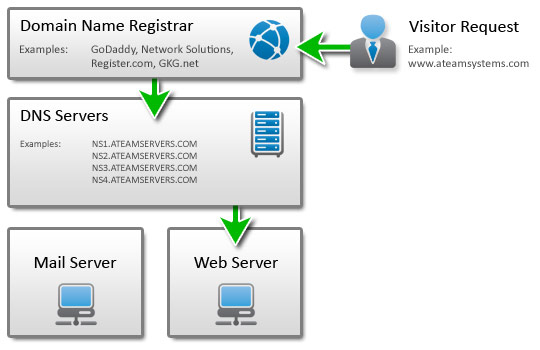How Registrars, DNS Servers, and Web Servers Work Together
One of the most common questions that arise when migrating customers from one hosting company to another is a variation on this subject. Most people are unaware of the multistage process that occurs between them typing in (for example) http://www.ateamsystems.com/ and the web page being displayed on their screen.
There are 3 main pieces required for any web site to work: The chart below details how these are accessed when a visitor goes to a web site.

* Please note this diagram has been simplified for clarity’s sake.
The first thing that happens when a visitor enters a web site address (for example http://www.ateamsystems.com/) is that their computer will contact their ISP, asking their ISP essentially ‘Where is http://www.ateamsystems.com/ ?’. This starts the process of finding which specific server on the entire Internet that is serving that website.
Domain Name Registrar
The Domain Name Registrars are companies who are allowed to sell (really rent) domains. Originally only Network Solutions was allowed to sell domain names, but now many other companies offer this service including GoDaddy, Name.com and GKG.Net to name a few.
For each domain that they have rented, the Domain Registrar keeps a list of the DNS Servers for that specific domain. When a visitor starts looking for an address, this list is sent. In our example, GKG.net (our Domain Registrar) maintains on our behalf a list of A-Team’s DNS servers for people asking about ‘ateamsystems.com’.
DNS Servers
Using the list of DNS Servers, the visitor asks “What is the address of ‘www.ateamsystems.com’?”. DNS Servers maintain a ‘map’ of a domain, specifically where visitors should be directed when they type in things like ‘www.domainname.com’ or send an email to ‘someone@domainname.com’.
Using our example, one of A-Team’s DNS Servers would be contacted and asked ‘Where is the web server for www.ateamsystems.com?’ and the DNS server would reply back with the web server’s IP Address. This is like a street address for the Internet and the last piece of information the visitor needs to get where they are going.
Web Server (for example)
Now that the visitor has the IP Address for the server it is looking for, it can ‘dial’ (connect) to it directly and request the web page the visitor had asked for. The web server will then begin transmitting the web page to the visitor’s browser.
That’s it! All of this happens in a fraction of a second.
Mixing, Matching and Combining
It is important to note that any or all of these layers can be combined with the same company (or not). For example GoDaddy provides service at all three layers: Domain Name Registration, DNS Hosting and Website Hosting. It is also possible (and common) to mix and match the companies which provide these layers for your domain. For example your web server does not have to be hosted with the same company as your mail server or DNS servers.

Nice Article.
Great article. It answered my question. Thanks.